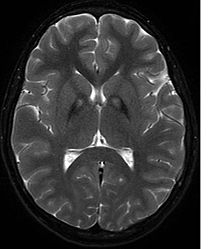Pantothenate kinase-associated neurodegeneration
| Classification according to ICD-10 | |
|---|---|
| G23.0 | Hallervorden-Spatz syndrome
Pigment degeneration of the pallid |
| ICD-10 online (WHO version 2019) | |
The pantothenate kinase-associated neurodegeneration (PKAN) to continue as Hallervorden-Spatz syndrome called (HSS) is a very rare neuro-degenerative disease , in which, particularly in the basal ganglia ( globus pallidus and substantia nigra demonstrate increased) levels of iron to let. Therefore it is subordinate to the group of diseases called neurodegeneration with iron deposition in the brain ( NBIA , English Neurodegeneration with Brain Iron Accumulation ). Originally known as just PKAN or the HSS, NBIA was considered synonymous with HSS. This autosomal recessive hereditary disease from the group of neuroaxonal dystrophies was first described in 1922 by Julius Hallervorden and Hugo Spatz . The prevalence is estimated at 1–3 affected people per 1 million people. In Germany at least 45 people (not including the unreported number) live with NBIA (as of 2008).
Pathogenesis
In the majority of sick patients, especially those with early onset, mutations in a gene coding for a pantothenate kinase ( PANK2 ) can be detected on chromosome 20p13 . This enzyme plays a central role in coenzyme A biosynthesis. An enzyme defect leads to an accumulation of cysteine , which in the presence of iron (especially in the substantia nigra and basal ganglia) leads to an increase in free radicals and thus causes oxidative damage to the brain. There is excessive deposition of iron and neuromelanin .
Course of disease
The disease usually begins in childhood, sometimes with pronounced symptoms as early as the first decade of life, but adult forms also occur. Initially, extrapyramidal movement disorders, in particular a gait disorder with a tendency to frequent falls or leg dystonia (90%), are in the foreground, and less often psychological abnormalities (10%). Movement disorders ( dystonia , choreoathetosis , tremor) with a rigid increase in muscle tone, hyperreflexia, and retardation or dementia develop over time . Dysarthria and dysphagia also occur regularly as the disease progresses. Retinitis pigmentosa or optic atrophy can also occur. In adults, Parkinson's plus syndrome with dementia, hyperreflexia and prominent dystonia dominates the clinical picture. The course of the disease is progressive, that is, the neurological condition of the patient continues to deteriorate over time.
Additional diagnostics
In addition to the laboratory-chemical exclusion of Wilson's disease and , optionally, neuroacanthocytosis , a magnetic resonance imaging examination of the brain leads to the confirmation of the diagnosis. Here, T2-weighted images in the globus pallidus show characteristic hypointensity caused by iron deposits with a central hyperintensity probably caused by gliosis. This characteristic finding is known as the "tiger's eye sign" (English eye of the tiger ) and is found in all patients with PANK2 mutations. A genetic test may reveal mutations in the PANK2 gene. A reliable diagnosis can only be made neuropathologically.
therapy
A causal therapy is not yet known; there are first attempts to treat the enzyme defect. Iron chelators such as deferoxamine have no effect, but there have been first attempts at therapy with the iron chelator deferiprone (trade name: Ferriprox) since 2007. The deep brain stimulation is used for dystonia and hyperkinesia as the predominant symptoms possibly in question. Hypokinesia can be treated with L-DOPA , hyperkinesia with anticholinergics such as B. Trihexyphenidyl . However, the effectiveness of L-DOPA in patients with mutations in the PANK2 gene is very questionable. Baclofen and / or benzodiazepines are often used for muscle relaxation and the associated pain relief .
Name of the disease
Because of Julius Hallervorden's involvement in the Third Reich's euthanasia program , it has been suggested that the disease (based on the genetic defect) be classified as pantothenate kinase-associated degeneration or (more generally) as neurodegeneration with iron deposition in the brain ( NBIA syndrome - N eurodegeneration with B rain I ron A ccumulation). The terms NBIA and PKAN are becoming more and more popular worldwide.
See also
Individual evidence
- ↑ Zhou et al. a .: A novel pantothenate kinase gene (PANK2) is defective in Hallervorden-Spatz syndrome. in: Nature genetics , 28.2001, 4 (Aug), pp. 345-349. PMID 11479594 ISSN 1061-4036
- ↑ Gregory, Hayflick: PKAN article at genereviews, revised version Jan. 2008
- ^ Disease names used by Nazi doctors
- ↑ M. Shevell: Hallervorden and history. In: The New England journal of medicine , 2.2003,1 (Jan), 348, pp. 3-4. PMID 12510036 ISSN 0028-4793
